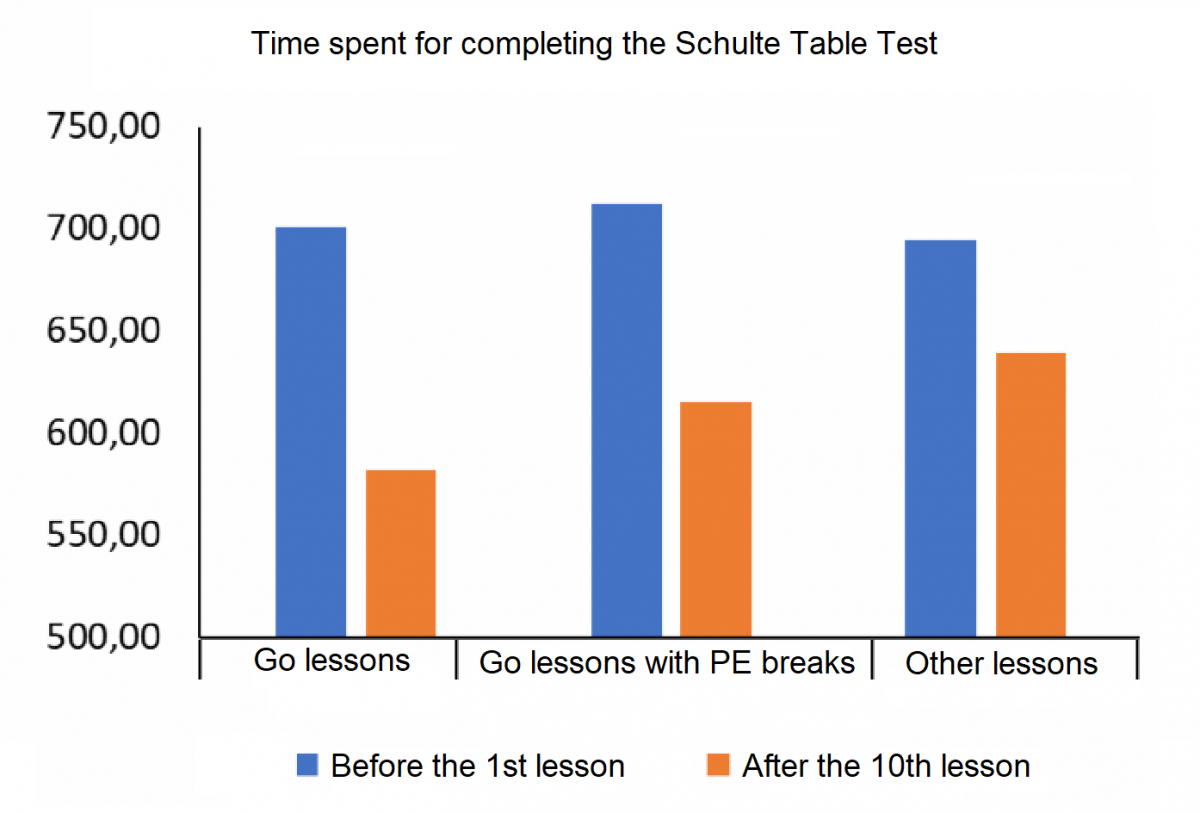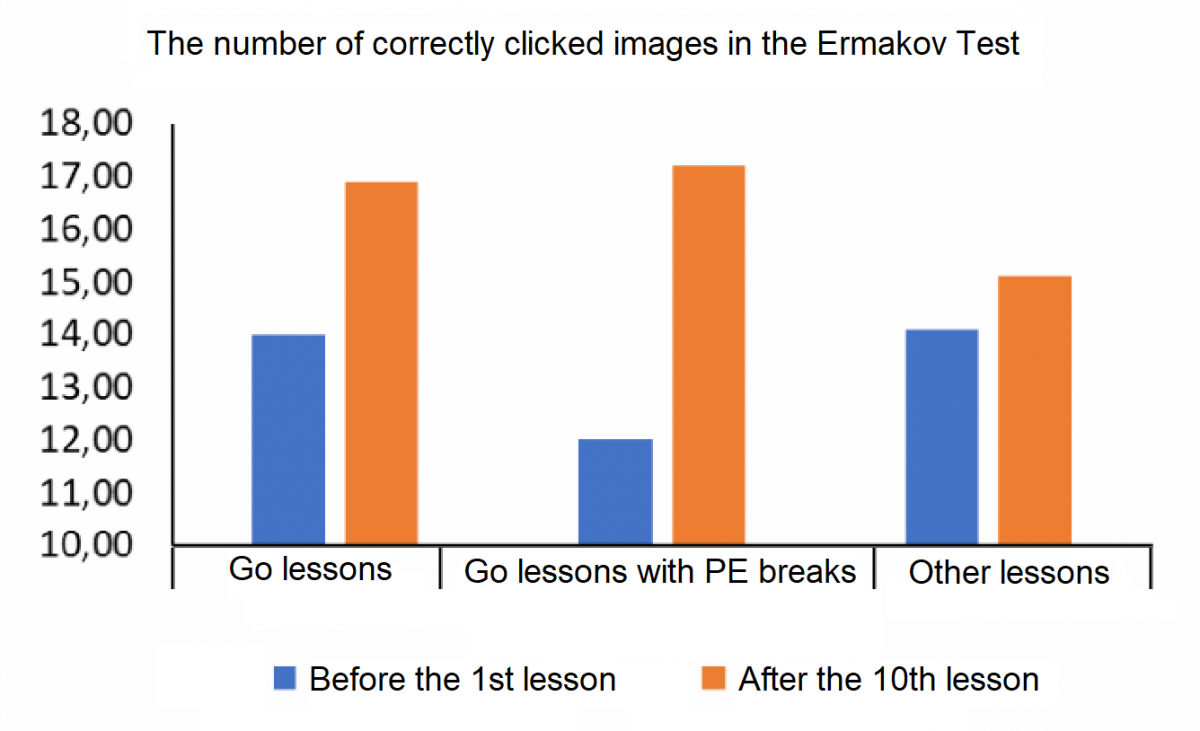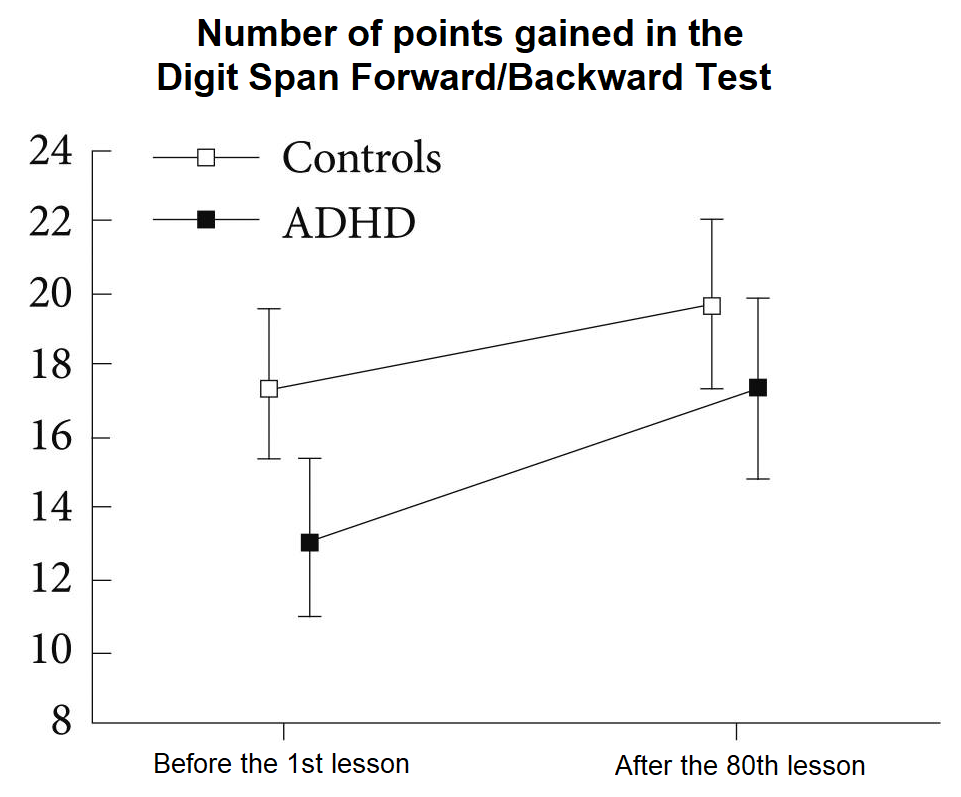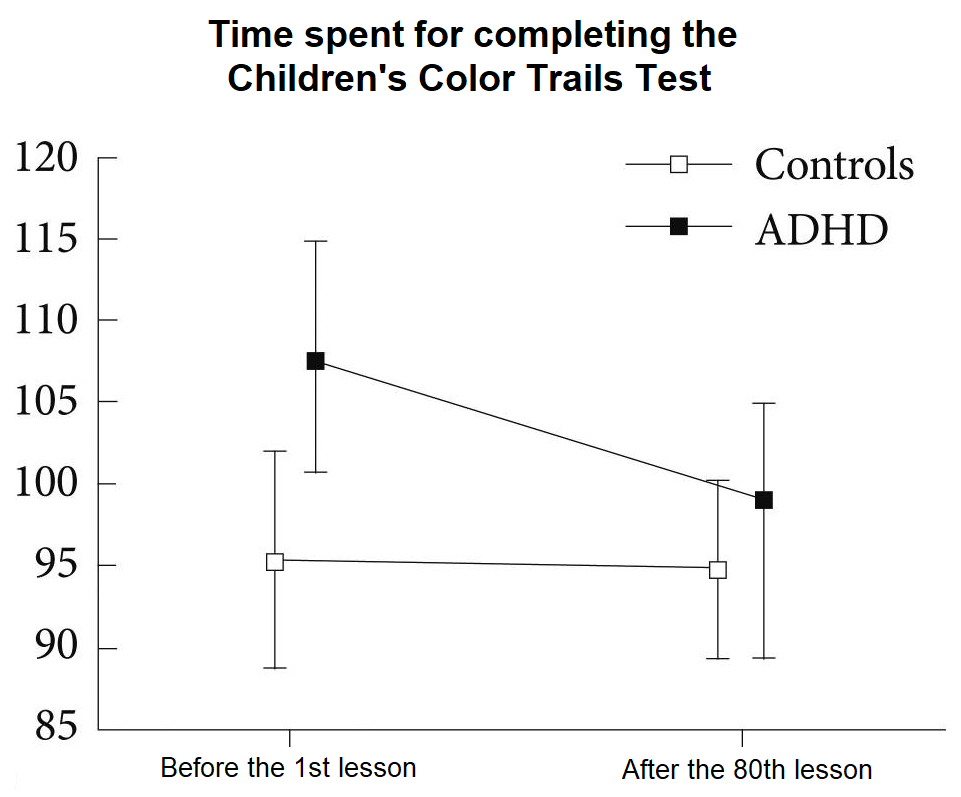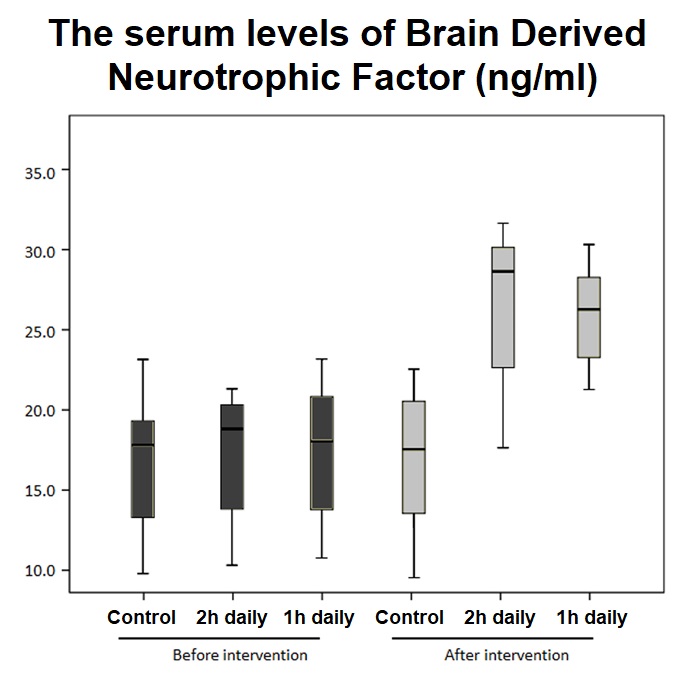Many people speak that studying the game of Go develops the students’ minds. But is it possible to prove it? In this article you will find the results of scientific research that measure the impact of Go lessons for human’s brain and thinking ability.
Cognitive and Neurodynamic Function of 6-year-old Children
30 children who attended the 1st class of primary school were parted into three groups of 10 children:
1st group: Children that started to study Go.
2nd group: Children that started to study Go and had a break for physical exercises on each Go lesson.
3rd group: Children that studied other subjects (instead of Go lessons).
In the 1st group the children took part in 10 Go lessons of 50 min each.
In the 2nd group the children took part in 10 Go lessons of 45 min each with additional 5 min break for physical exercises in the middle of each lesson.
The Go lessons were held twice a week for about a month.
Each student from each group took part in the Schulte Table Test and Ermakov Test twice.
First time before the start of 10-lessons-Go-training and second time after the Go lessons ended.
Schulte Table Test
In this test the children needed to sort the randomly put numbers in order from 1 to 25 on five alternately shown tables. The goal of the test was to sort the numbers on all tables as fast as possible.
Results
1st group: The time of completing the test after all Go lessons was about 17% lower than the time of completing the test before the start of Go lessons.
2nd group: The time of completing the test after all Go lessons was about 14% lower than the time of completing the test before the start of Go lessons.
3rd group: The time of completing the second test was about 8% lower than the time of completing the first test.
Summarizing, the children who took part in Go lessons were able to sort the numbers faster than the children who took part in other lessons.
Ermakov Test
In this test the children were able to see twelve buttons. It was necessary to click on a correct button whenever an image appeared on it. The image was displayed every time in another place. The time interval between appearances of the image was not constant either. The goal of the test was to click on the image as many times as possible within a specified time limit. Each child had three attempts.
Results
1st group: The number of correctly clicked images in the third attempt of the test after all Go lessons was about 21% higher than the number of correctly clicked images in the third attempt of the test before the start of Go lessons.
2nd group: The number of correctly clicked images in the third attempt of the test after all Go lessons was about 43% higher than the number of correctly clicked images in the third attempt of the test before the start of Go lessons.
3rd group: The number of correctly clicked images in the third attempt of the second test was about 7% higher than the number of correctly clicked images in the third attempt of the first test.
Summarizing, the children who took part in the Go lessons were able to click on the image more times than the children who didn’t take part in Go lessons.
A significantly higher number of correct clicks had children who joined the Go lessons with breaks for physical exercises.
Conclusions
According to the Schulte Table Test:
Studying the game of Go helps in mental performance and work efficiency.
According to the Ermakov Test:
Studying the game of Go helps in being able to switch attention faster, although studying the game of Go in combination with physical exercises helps in it even more.
Source of the original article
The original article was published on 31st December 2018 in the International Journal of Physical Education and Sport.
The research were run by Zhanneta Kozina, Evgenii Abrosimov, Danil Safronov, Lyudmila Peretyaha, Tetiana Dovzhenko and Natalia Bugayets.
The original article can be found here.
Improved Cognitive Function and Brain Activity among Children with ADHD
34 children aged between 7 and 12 who didn’t have experience in studying Go were parted into two groups of 17 children:
1st group: Children with untreated ADHD.
2nd group: Healthy children.
Children in both groups took part in 2h Go lessons, 5 times per week, for 16 weeks.
All children attended their regular lessons at school and joined the Go lessons as an after-school activity.
Before and after the study each student took part in several tests including Digit Span Forward/Backward Test and Children’s Color Trails Test.
During the study the children’s behaviour was also analyzed according to DuPaul’s ADHD Rating Scale.
Digit Span Forward/Backward Test
In this test the children had been listening to various series of numbers. After each series they needed to repeat the sequence of numbers in the correct order – first forward and then backward. The goal of the test was to speak the sequences of numbers correctly.
Results
1st group: The number of points gained for correct repetitions in the test after all Go lessons was about 34% higher than the number of points gained in the test before the start of Go lessons.
2nd group: The number of points gained for correct repetitions in the test after all Go lessons was about 14% higher than the number of points gained in the test before the start of Go lessons.
Summarizing, children from both groups achieved better results in the test after the 16 weeks of Go lessons. In each test the healthy children had more points than children with ADHD. However, children with ADHD made more progress than healthy children.
Children’s Color Trails Test
In this test the children had been looking at various numbers in two colours. It was necessary to connect numbers in an ascending order in a way that every even number was in a different colour than the odd number. The goal of the test was to connect the numbers as fast as possible.
Results
1st group: The time of completing the second test was about 8% lower than the time of completing the first test.
2nd group: The time of completing the second test was less than 1% lower than the time of completing the first test.
Summarizing, the children with ADHD achieved better results in the test after the 16 weeks of Go lessons. The results of healthy children remained on the similar level. However, in each test the healthy children were faster than children with ADHD.
DuPaul’s ADHD Rating Scale
In this analysis parents of each child needed to assess their child’s behaviour in relation to ADHD. A special scale with a point system was used.
Results
1st group: During the 16 weeks of Go lessons the ADHD symptoms were about 25% lower than before the start of learning Go.
Conclusions
According to the Digit Span Forward/Backward Test:
Studying the game of Go helps in increasing the verbal working memory.
According to the Children’s Color Trails Test:
Studying the game of Go helps children with ADHD to improve their cognitive flexibility.
According to the DuPaul’s ADHD Rating Scale:
Studying the game of Go helps children with ADHD to improve their inattention.
Source of the original article
The original article was published on 11th April 2014 in the Psychiatry Investigation Journal of the Korean Neuropsychiatry Association.
The research were run by Se Hee Kim, Doug Hyun Han, Young Sik Lee, Bung-Nyun Kim, Jae Hoon Cheong and Sang Ho Han.
The original article can be found here.
The article with openable charts is available here.
Intervention in Alzheimer Disease
147 patients with Alzheimer disease who didn’t have experience in studying Go were parted into three groups of 49 patients.
1st group: Patients who started to study Go for 2h per day.
2nd group: Patients who started to study Go for 1h per day.
3rd group: Patients who didn’t start to study Go.
The patients took part in Go lessons daily, for 6 months.
5 ml of blood was taken from each patient before and after the study in order to measure the Brain Derived Neurotrophic Factor.
Additionally, before and after the study each patient took part in several neuropsychological tests including Kimberley Indigenous Cognitive Assessment of Depression.
Brain Derived Neurotrophic Factor
This protein plays a critical role in learning and in memory of a human.
Low level of Brain Derived Neurotrophic Factor is also one of the key causes of depression.
There is a deficit of this protein in organisms of patients with Alzheimer Disease.
Results
1st group: The amount of the Brain Derived Neurotrophic Factor in blood after the 6 months of Go lessons was about 53% higher than before the start of learning Go.
2nd group: The amount of the Brain Derived Neurotrophic Factor in blood after the 6 months of Go lessons was about 46% higher than before the start of learning Go.
3rd group: The amount of the Brain Derived Neurotrophic Factor in blood after 6 months was about 1% lower than before the study.
The results were taken from the average among 95% of samples (the remaining 5% were the highest and lowest results that weren’t counted in the average).
Summarizing, patients who took part in Go lessons had a significant increase of Brain Derived Neurotrophic Factor in blood.
A bit bigger increase of this protein in blood had patients who studied Go for 2h per day instead of 1h per day.
The amount of this protein in organisms of patients who didn’t take part in Go lessons remained on the similar level.
Kimberley Indigenous Cognitive Assessment of Depression
In this test the patients needed to give answers on 11 questions that are related with depression. For every question they could answer:
– “never”
– “sometimes”
– “a lot”
– “all the time”
The patients were asked about e.g. if they feel tired and have no energy, if they think of hurting themselves, if they feel like they are doing things they usually like doing or if they have thoughts that they would be better off dead.
Results
As suspected from the increase of Brain Derived Neurotrophic Factor in blood, the answers of patients who took part in the 6-month Go training were much more positive after the Go training than before the study.
The full table with answers is available in the original article.
Conclusions
Studying the game of Go helps in increasing the amount of a special protein in blood of patients with Alzheimer Disease. That protein helps human in learning new things and in memorizing.
Studying the game of Go helps patients with Alzheimer Disease also in reducing the symptoms of depression.
Source of the original article
The original article was published on 25th August 2015 in the Frontiers in Aging Neuroscience Journal.
The research were run by Qiao Lin, Yunpeng Cao and Jie Gao.
The original article can be found here.
More research about the help of the game of Go for human’s brain can be found e.g. at the bottom of each original article in section ”References”.
